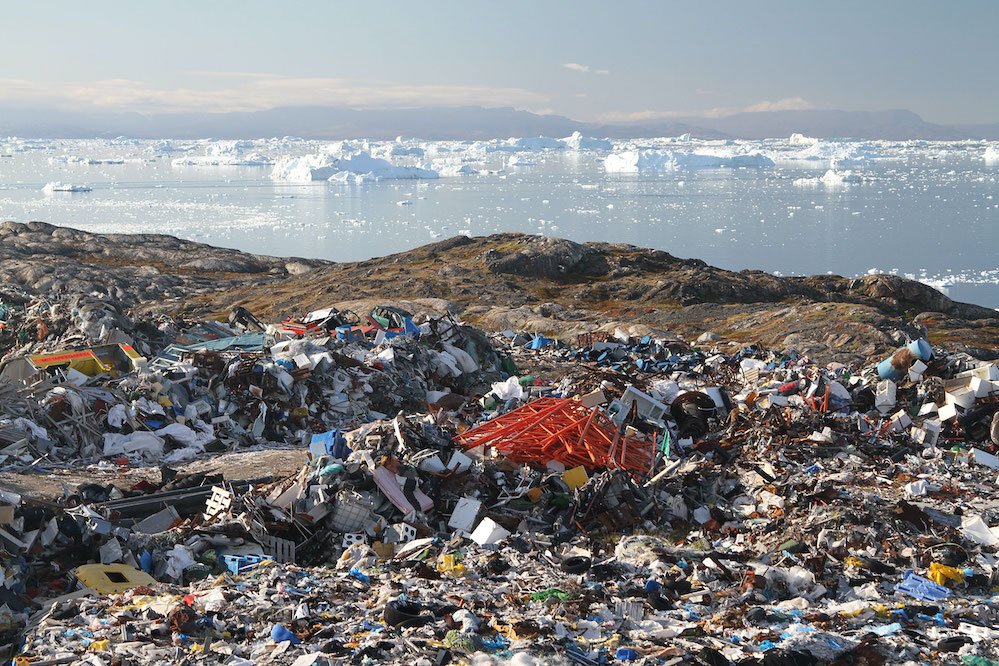Two new incinerators aim to ease Greenland’s trash problem
They’ll also provide hot water to homes and businesses in Nuuk and Sisimiut
Plastic and other light material blown from Greenland’s open dumps often winds up in nearby fjords. (Arctic DTU)
Two new trash-to-energy systems are expected to provide residents of Greenland’s two largest cities with heat and hot water while at the same time helping the country address a lack of waste management facilities.
When completed in 2021 and 2022, the new two incinerators in Nuuk and Sisimiut, each being built at a cost of 200 million kroner (CA$42 million), will produce hot water that is piped to homes and businesses in district heating networks.
The proposal to centralize waste processing at two facilities was put forward in 2019 by Naalakkersuisut, the administration, and formalized in a 10-year national waste-management plan published in June.
Both incinerators will have a capacity of 60 tons daily, and, according to the proposal, the incinerator in Nuuk (population 17,000) will be supplied with waste collected locally, while the incinerator in Sisimiut (population 5,500) will receive waste sailed in from the rest of the country.
In connection with construction of the two incinerators, transfer stations will be established in towns and hamlets where waste can be stored until it is shipped to Sisimiut. Glass, metal and other types of waste that cannot be incinerated will be removed, sorted and stored at local dumps.
The two incinerators will replace the 20 or so incinerators that are currently in operation in other towns and hamlets. Another 20 incinerators are currently inactive, leaving residents in the communities they serve with only an open dump for waste disposal.
In many cases, the dumps are unstaffed, and that, combined with a situation in which the country produces 30 percent more waste than it existing incinerators can process, has led to unauthorized waste dumping and incineration.
In addition to being eyesores, the dumps pollute the ground where they are situated, while light items like plastic are carried by the wind, polluting a wider area and, in some cases, winding up in adjacent fjords or local sources of drinking water.
Initiatives are underway to make improvements at some of the dumps that will reduce flyaway waste, either by fencing the sites in or by installing machines that can compress waste into bales that are more easily stored and shipped. The improvements are part of a 10-year, 50-million kroner initiative by Naalakkersuisut to improve waste management.
This article originally appeared at Arctic Today and is republished with permission.




While I deplore the use of incineration for solid waste disposal, the plan to consolidate 20 incinerators into two locations only combined with an aggressive recycling and sorting program seems to be a viable yet still distasteful “short” term solution. I feel badly for the host communities who will be saddled with the massive amounts of pollution these incinerators will generate. No incinerator even those self proclaimed ”state of the art” eliminates all pollution. Cogeneration of heat from the facilities is a noble goal however if the primary fuel in addition to trash still used to burn the wastes exceeds the amount produced by the facility that claim is farcical and a smokescreen. To the people of the communities and the surrounding areas I implore you to use vigilance to ensure these facilities if built do not get the permission to also burn auxiliary fuels such as hazardous wastes, oils, sludges, tires and other industrial poisons.
If trash is incinerated at 900 to 1000 degree’s, the majority of volatile organic compounds and other persistent organic pollutants are destroyed. The resultant fly ash is an inert byproduct that can then be separated from component ferrous (aka magnetic) metals and aluminum can be captured as well using a more elaborate paramagnetic technique.
There is a waste to energy incinerator in Vancouver that processes most of BC’s trash to generate electricity. Unfortunately, most of BC’s trash is still driven south of the border into the United States and placed into for-profit landfills.
However, even then it’s not a terrible thing because Waste to energy systems are becoming increasingly popular with landfills to capture methane byproduct emissions from rotting garbage that has been buried under sediment and tapped as artificial gas wells.
Burning trash is currently the method being used all over Nunavut to deal with trash. The process involves pouring diesel fuel over a pile of garbage and lighting a match. All of the persistent organic pollutants are released in this manner as a point source of pollution.
Waste incineration might not be the right choice for the south, especially when it comes to good alternatives like recycling but for the arctic it is the best possible solution that is available at the moment.
Trash has to go somewhere. Burn it. Recycle it. Crush it. Bury it. Ship it to China.
.
Nunavut has the benefit of thousands and thousands of km of land that will never be used or developed.
.
I don’t see why instead of entertaining expensive options the city of Iqaluit doesn’t just get a dump truck, build a dirt road 100km out, and dump it. Better there than in city limits and should be cheap enough compared to alternatives. If the pool cost tens of millions this will be hundreds. No need to complicate things – dig hole, fill hole. The future will take care of this when technology improves and we have cheap space travel and start sending trash to the sun.
I’d imagine that most of the ‘waste’ is originally imported. The US is expanding its ability to make plastic. More and more plastic will be headed to Greenland. A study would show which way is best. Quantify pollution now. Quantify pollution under new planned system. Quantify future pollution based on trends. Until the world changes pollution will increase! Shouldn’t producers be responsible for end of useful life issues for their products?
I ran across this article while investigating trash collection alternatives after my home owner’s association’s trash service just discarded our contract (that still had 4 years of a fixed rate) and increased our rates by 32%. I have seen a lot of rhetoric by bleeding hearts saying incineration is evil, landfills are evil, capitalism is evil, etc. I have never thought digging a hole in the ground and burying our trash was a good idea. That has to be among the stupidest ideas ever. The thing is, not everything can be recycled…and the trash has to go somewhere. Paper can be burned or, depending on its original production method, composted. Yes, you can recycle it, too, but it’s always an inferior product. Glass can be recycled infinitely and is always as good as new. Same with metals. Plastic is evil and I’d love to see it go away, but that’s beyond my power to effectuate. What I would appreciate seeing is more discussion focused on practical ways to reduce the need for trash collection and disposal and then practical ways to address what’s left over. Incineration is a great solution as long as the nasties are kept out of the fire, but that starts at home. It’s not reasonable to put the onus on the incinerator operator to catch every single AA battery and CFL light bulb that goes through the facility.